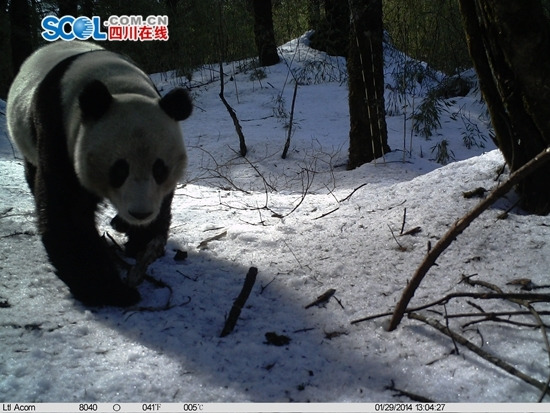
Panda Luxin. (File photo/sichuan.scol.com.cn)
Luxin was abducted after collapsing from hunger and sickness along a country road in Luding County, Sichuan Province. The lady panda has never returned home.
Six years after being taken, Luxin is now a mother far from the mountains where she grew up, raising a healthy cub along with her mate. Her ability to adapt to life in the new environment is being hailed as an innovation among national efforts to rekindle the population of the endangered species.
"I guess Luxin is happy with her new life," said Huang Yan, deputy chief engineer at the China Conservation and Research Center for Giant Panda (CCRCGP), which perpetrated Luxin's unexpected move in March 2009.
"This is our first success in increasing gene diversity of small isolated panda communities by introducing outsiders," he said, emphasizing the importance of gene diversity to the survival of a species.
Luxin was five when she was spotted in distress by a rural passerby, who informed the CCRCGP. Rescuers placed her carefully into a cage and transported her to a research base in Ya'an.
Veterinarians said Luxin suffered from severe dehydration caused by infection of the digestive tract. After her recovery, the wild panda was relocated to Liziping Nature Reserve in Xiaoxiangling Mountains, 100 km away from her home in Qionglai Mountains.
Habitat loss and fragmentation have separated panda groups in nature. Huang said China has at least 30 isolated groups each with a small population of less than 50 pandas.
Pandas in such small communities have limited mating options, thus have a high possibility of inbreeding. It may lead to birth defects and, even worse, death of newborns.
As a panda in her reproductive prime, Luxin was assigned a tough job to find a mate among unacquainted guys in the 30-wild panda community in Xiaoxiangling Mountains.
"Without help, they may go extinct after a century," said Huang Feng, chief of the reserve's management office.
Luxin is one of the first to be relocated for such purposes. Her success or failure in finding acceptance in the group and mothering a kid is a tipping point for Huang's research.
The task, however, is so dangerous and might result in deaths. In 2006, five-year-old male Xiangxiang became China's first captive-bred panda released to the wild, but was found dead one year later after fighting with aboriginal residents over food and territory.
Luxin might face the same fate, in addition to having to adapt to a different type of bamboo to eat, new ways of inter-personal communication and a changed local climate.
"She was chosen because females are usually more easily accepted by fellow pandas, while males are often seen as new threats," Huang said.
A sensing device, or an ID chip, was implanted under her skin and a GPS collar was put around her neck. With a bit homesickness, fear to the unknown but barely a look back, Luxin disappeared into the bamboo in late April 2009.
Up to 12 researchers have kept a watchful eye on her with the help of radio positioning tools and infrared monitoring cameras since the day she was released.
It's best that human contact is kept to a minimum, but the collar was abandoned by Luxin, for unknown reasons, several months later.
Huge efforts went into recovering the data. Thanks to the sensing chip, they distinguished Luxin from the pack of pandas and replaced the collar.
One year later, the researchers went to check on her health, attempting to re-capture her by placing familiar bamboo dishes in a cage.
When they checked on the cage, they found Luxin had been captured but managed to dig a hole into the ground and escaped.
"She's quite smart," Huang said.
In 2011, eventually, they caught her and performed the physical.
A 7.0-magnitude earthquake that hit Luxin's new home in April 2013 damaged the panda's habitat, but the "kidnappers" didn't lose track of Luxin, who survived the ordeal in good health.
Years passed, Huang and his colleagues scarcely saw Luxin via their infrared cameras.
To their surprise, six photos and two videos recorded in March and May 2014 revealed Luxin gave birth to a panda cub.
Did Luxin find her mate? Is the cub her baby? They quickly sought answers.
Extracting and analyzing DNA from the mother and cub's feces, they ran DNA tests.
"After more than one year's investigation, we found that Luxin has married a local wild panda named LZP 54, and gave birth to a baby in August 2012," Yang Xuyu, head of the provincial Wild Animal Preservation Station, told Xinhua.
"The success means it's feasible to build up a population in small panda communities by sending 'strangers' to different groups," Huang said.
During Luxin's disappearance, nationwide researchers made other efforts to boost the quantity and quality of panda population.
Despite Xiangxiang's failure, three more captive-bred giant pandas were released into Liziping Nature Reserve in 2012, 2013 and 2014. Another two pandas bred in captivity will be released into the wild soon.
Researchers are also trying to build bamboo corridors between the habitats of different panda groups, which have been isolated after their original homeland was cut off to pieces by highways, tunnels or other areas of human activities.
Thanks to ecological initiatives, strict laws and greater public awareness, the number of pandas in China's wild has increased to 1,864 by the end of 2013.
"The sacrifice panda pioneers have made for the species' own survival will be remembered," Huang said.
The average life of the wild giant panda is 15 years. Luxin, 11, has entered her middle age.
Like most mothers, she cares for her young in hopes that it will thrive. Huang and his colleagues quietly guard them for the thriving.


















































